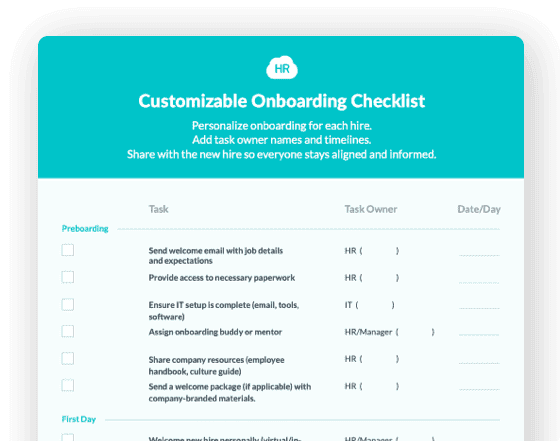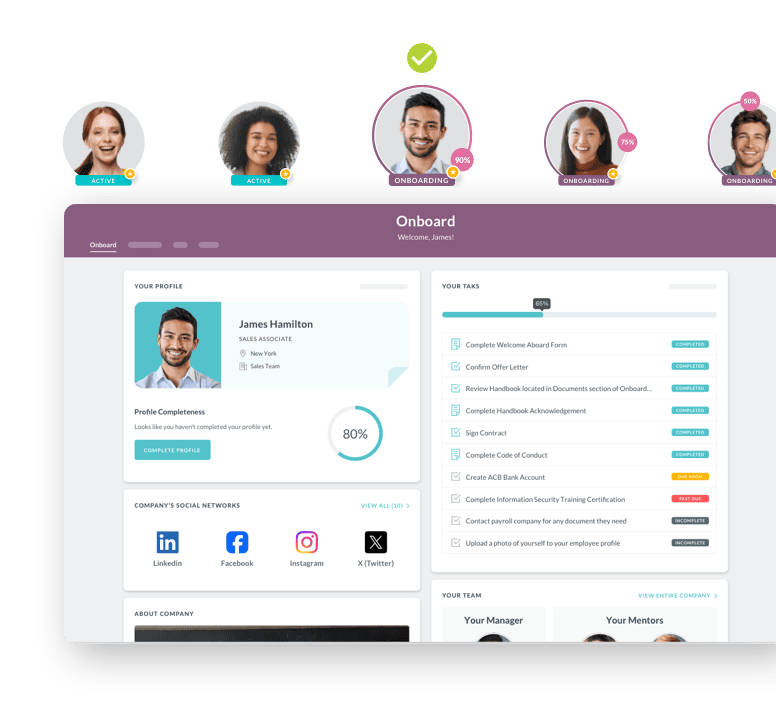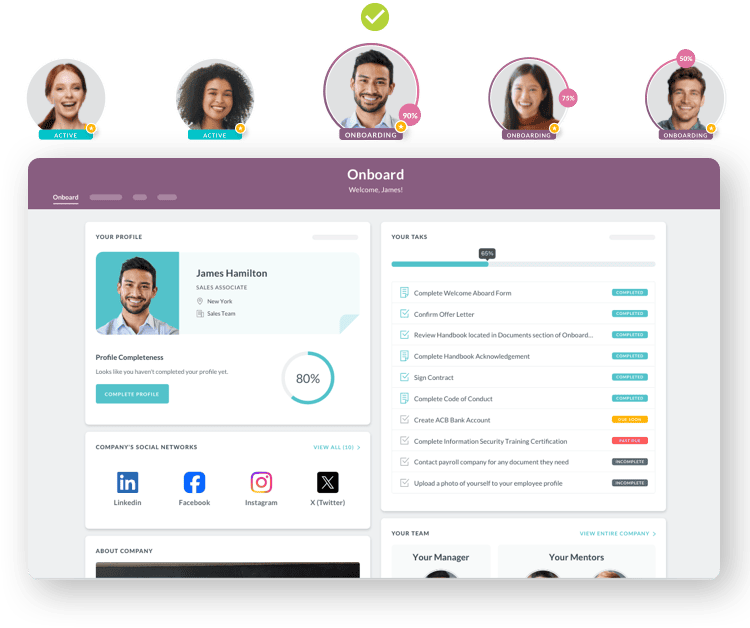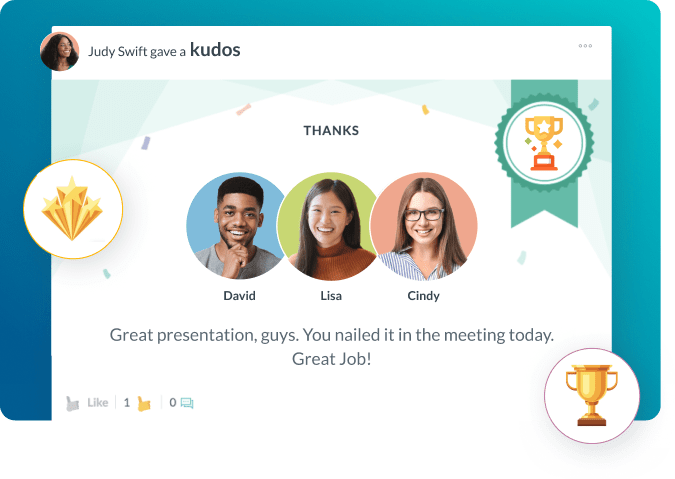Personnel Sourcing
- What Makes Personnel Sourcing Essential for Business Success
- Core Components Every Personnel Sourcing Strategy Must Include
- Personnel Sourcing Methods Comparison
- Proven Best Practices That Drive Personnel Sourcing Results
- Common Personnel Sourcing Pitfalls You Must Avoid
- How Personnel Sourcing Works Across Different Industries
- Your Step-by-Step Personnel Sourcing Implementation Plan
- The Future of Personnel Sourcing and What It Means for Your Organization

 Cut onboarding time
by 60%—here's the
Ultimate Checklist
that helped do it.
Cut onboarding time
by 60%—here's the
Ultimate Checklist
that helped do it.

Personnel sourcing is the proactive process of identifying, attracting, and building relationships with qualified candidates to create a sustainable talent pipeline for current and future hiring needs. Unlike reactive recruiting that responds to open positions, personnel sourcing focuses on continuous candidate engagement, helping organizations stay ahead in competitive talent markets. This strategic approach transforms how businesses connect with top talent, reducing time-to-hire while improving candidate quality.
Today's hiring landscape demands more than posting job ads and hoping strong candidates apply. Organizations face significant talent shortages, with research from Peter Cappelli at Wharton revealing that companies have never done as much hiring as they do today yet have never done a worse job of it. Personnel sourcing offers a solution by building relationships with potential employees before positions even open. This forward-thinking method creates competitive advantages that directly impact your bottom line through reduced recruitment costs, faster hiring cycles, and better quality hires.
What Makes Personnel Sourcing Essential for Business Success
Personnel sourcing serves as the foundation for effective talent acquisition. The approach moves beyond traditional recruitment by actively seeking out candidates who may not be actively job hunting. This matters because 70% of the global workforce remains open to opportunities despite not actively searching for new positions. Your competitors likely target the same talent pool, making proactive sourcing crucial for staying ahead.
Organizations that invest in personnel sourcing create robust talent pipelines that deliver measurable results. Companies experience shorter hiring cycles, lower cost-per-hire metrics, and improved retention rates. When positions open, you already have pre-qualified candidates ready for conversations. This readiness proves especially valuable for hard-to-fill roles requiring specialized skills or executive positions where finding the right fit takes considerable time.
Core Components Every Personnel Sourcing Strategy Must Include
Successful personnel sourcing requires several interconnected elements working together. Understanding these components helps you build an effective approach that delivers consistent results.
Candidate Persona Development:
Define ideal candidate profiles based on skills, experience, cultural fit, and career trajectory to target sourcing efforts accurately.
Multi-Channel Talent Discovery:
Leverage LinkedIn, industry-specific platforms, social media, professional networks, and employee referrals to cast a wide yet targeted net.
Relationship Building:
Establish authentic connections with potential candidates through personalized outreach, regular touchpoints, and value-added communications.
Pipeline Management:
Organize and track candidate interactions using applicant tracking systems and CRM tools that maintain engagement over time.
Continuous Engagement:
Keep passive candidates interested through company updates, industry insights, and career development resources even when no immediate openings exist.
Data-Driven Optimization:
Monitor recruitment funnel metrics including source effectiveness, conversion rates, and pipeline health to refine your approach continuously.
Personnel Sourcing Methods Comparison
|
Sourcing Method |
Best For |
Average Time Investment |
Candidate Quality |
Cost Efficiency |
|
Employee Referrals |
Cultural fit and immediate needs |
Low |
High |
Very High |
|
Social Media Outreach |
Passive candidates and employer branding |
Medium |
Medium to High |
High |
|
Boolean Search (LinkedIn/Job Boards) |
Specific skill requirements |
Medium |
High |
Medium |
|
Recruitment Events & Networking |
Executive roles and niche expertise |
High |
Very High |
Low to Medium |
|
Talent Database Mining |
Quick fills and repeat roles |
Low |
Medium |
Very High |
|
Campus Recruiting |
Entry-level and early career talent |
High |
Medium |
Medium |
Proven Best Practices That Drive Personnel Sourcing Results
Implementing personnel sourcing effectively requires discipline and strategic thinking. These best practices help you maximize your sourcing investments while building lasting candidate relationships.
Start by aligning your sourcing strategy with broader business objectives. Meet regularly with department leaders to understand upcoming projects, expansion plans, and potential skill gaps. This forward-looking approach allows you to build talent pipelines that match organizational needs before urgent hiring pressures emerge. According to research in Harvard Business Review, companies that integrate workforce planning with business strategy create more resilient talent acquisition functions.
Personalization makes all the difference in candidate engagement. Generic outreach messages get ignored, while tailored communications that reference specific accomplishments or shared interests generate meaningful responses. Research candidate backgrounds thoroughly before reaching out. Mention relevant projects they've worked on, articles they've written, or mutual connections you share. This attention to detail demonstrates genuine interest rather than mass outreach.
Build your employer brand consistently across all channels. Your company's reputation directly impacts sourcing success, with 86% of candidates avoiding organizations with negative reputations. Showcase your culture through employee testimonials, behind-the-scenes content, and authentic stories that highlight what makes your workplace special. Strong employer branding reduces time-to-hire and lowers salary expectations because candidates want to work for respected organizations.
Leverage technology strategically without losing the human touch. Recruitment tools and applicant tracking systems streamline administrative tasks, but personal relationships still drive hiring decisions. Use automation for data management and candidate tracking while maintaining authentic one-on-one interactions that build trust and rapport.
Create structured candidate nurturing programs that keep your talent pipeline warm. Send quarterly check-ins, share relevant industry news, acknowledge professional milestones, and provide career development resources. These touchpoints maintain relationships without overwhelming candidates with constant job pitches. When the right opportunity emerges, you'll be top of mind.
Measure what matters by tracking key performance indicators that reflect sourcing effectiveness. Monitor metrics including sourcing channel performance, candidate response rates, pipeline conversion ratios, quality-of-hire scores, and time-from-contact-to-interview. This data reveals what works and where to adjust your approach for better results.


Common Personnel Sourcing Pitfalls You Must Avoid
Even experienced talent acquisition professionals make mistakes that undermine sourcing effectiveness. Recognizing these pitfalls helps you avoid costly errors and maintain productive candidate relationships.
Neglecting passive candidates represents a critical missed opportunity. Most highly skilled professionals aren't actively job hunting but remain open to compelling opportunities. Focusing solely on active job seekers limits your talent pool dramatically. Develop strategies specifically designed to engage passive candidates through relationship building rather than immediate job pitches.
Poor data management creates chaos that damages candidate experience and wastes valuable time. Inconsistent tracking systems, duplicate candidate records, and inadequate notes about previous interactions lead to embarrassing mistakes like reaching out to the same person multiple times with identical messages. Implement robust applicant tracking systems that maintain comprehensive candidate histories and enable seamless handoffs between team members.
Rushing the relationship-building process backfires regularly. Personnel sourcing succeeds through genuine connections developed over time, not transactional exchanges. Candidates sense when recruiters view them merely as requisition fillers rather than professionals with career goals and aspirations. Invest time understanding what candidates seek in their next role before pitching opportunities.
Ignoring diversity and inclusion in sourcing practices perpetuates homogeneous workforces that lack the innovation and perspectives diverse teams provide. Relying on narrow sourcing channels and unconscious bias in candidate evaluation limits your talent pool. Implement structured processes that expand where you source candidates and how you evaluate their potential.
How Personnel Sourcing Works Across Different Industries
Personnel sourcing adapts to industry-specific needs while maintaining core principles. Understanding how different sectors apply sourcing strategies provides valuable insights for your own approach.
Healthcare organizations face acute talent shortages for specialized roles ranging from nurses to medical technicians. These employers succeed by building relationships with nursing schools, attending medical conferences, and maintaining alumni networks from training programs. They often establish talent communities where healthcare professionals receive continuing education resources and industry updates, creating natural pipelines for future openings. The emphasis centers on long-term relationship building rather than immediate hiring.
Technology companies compete fiercely for software engineers, data scientists, and product managers. Their sourcing strategies heavily leverage GitHub, Stack Overflow, and technical communities where developers naturally congregate. Successful tech firms participate actively in open-source projects, sponsor hackathons, and maintain strong engineering blogs that showcase technical culture. They recognize that top technical talent evaluates employers based on engineering practices, technology stacks, and learning opportunities rather than just compensation.
Manufacturing and logistics sectors struggle filling skilled trades positions including welders, electricians, and machine operators. These industries find success through partnerships with vocational schools, apprenticeship programs, and industry associations. They emphasize career advancement pathways and training programs that appeal to candidates seeking stable careers with clear growth trajectories. Employee referral programs work particularly well in manufacturing because skilled tradespeople maintain extensive professional networks within their specialties.
Your Step-by-Step Personnel Sourcing Implementation Plan
Implementing effective personnel sourcing requires systematic execution. Follow this roadmap to build sustainable talent pipelines that serve your organization's needs.
Step 1: Conduct Workforce Planning Analysis.
Meet with department leaders to identify critical roles, upcoming projects, and anticipated skill requirements for the next 12-18 months. Document timing, required competencies, and ideal candidate profiles for each position category.
Step 2: Audit Your Current Talent Acquisition Capabilities.
Assess existing sourcing channels, technology tools, team skills, and employer brand strength. Identify gaps between current capabilities and what your workforce plan demands.
Step 3: Develop Ideal Candidate Personas for Priority Roles.
Create detailed profiles including technical skills, experience levels, educational backgrounds, career motivations, and where these candidates spend time professionally. Use these personas to guide all sourcing activities.
Step 4: Select and Implement Appropriate Sourcing Technology.
Choose applicant tracking systems and recruitment tools that support your sourcing strategy. Ensure proper integration with existing HR systems and train team members thoroughly on new platforms.
Step 5: Launch Multi-Channel Sourcing Campaigns.
Activate employee referral programs, establish social media presence, join relevant professional communities, and begin building relationships with target candidates. Personalize all outreach and focus on value exchange rather than immediate hiring.
Step 6: Build Candidate Nurturing Workflows.
Create communication sequences that maintain engagement without overwhelming prospects. Share company updates, industry insights, and career resources at regular intervals. Track interactions and adjust based on candidate responsiveness.
Step 7: Measure Performance and Optimize Continuously.
Establish baseline metrics for sourcing effectiveness and monitor progress weekly. Conduct monthly reviews that examine what's working, what needs adjustment, and where to allocate resources for maximum impact.
Step 8: Integrate Sourcing with Onboarding.
Connect your sourcing pipeline to seamless onboarding experiences that maintain momentum from first contact through successful integration into your team. This end-to-end approach maximizes return on sourcing investments.
The Future of Personnel Sourcing and What It Means for Your Organization
Personnel sourcing continues evolving rapidly as technology, candidate expectations, and labor market dynamics shift. Understanding emerging trends positions your organization to stay competitive in the ongoing war for talent.
Artificial intelligence and machine learning transform how sourcers identify and engage candidates. Predictive analytics now forecast future hiring needs based on business trends, seasonal patterns, and historical data. AI-powered tools analyze vast candidate databases to surface profiles matching specific criteria while reducing unconscious bias in initial screening. However, the human element remains essential for relationship building and cultural fit assessment. According to SHRM research, successful organizations blend technology efficiency with authentic human connection.
Skills-based hiring reshapes how organizations evaluate candidates. Rather than focusing primarily on degrees and job titles, forward-thinking employers assess specific competencies and learning agility. This shift expands talent pools by recognizing non-traditional candidates who can grow into roles through training and development. Personnel sourcers increasingly need skills assessment frameworks and the ability to identify transferable skills across industries.
Remote work permanently altered talent sourcing by removing geographic constraints. Organizations now compete globally for talent, creating both opportunities and challenges. Successful sourcing strategies embrace location flexibility while building processes that support virtual relationship building and remote onboarding. Companies that master distributed hiring gain access to exponentially larger talent pools.
Candidate experience expectations continue rising as talented professionals gain more choices about where they work. Every interaction during the sourcing process shapes employer brand perception. Organizations must deliver responsive, respectful, and personalized experiences at every touchpoint. Those that treat candidates as valued professionals rather than resume submissions earn reputational advantages that compound over time.
The shift toward continuous talent engagement rather than episodic recruiting represents the most fundamental change in personnel sourcing. Organizations increasingly adopt always-on sourcing mindsets where building candidate relationships becomes ongoing work rather than something triggered by open requisitions. This evolution requires different team structures, technology investments, and performance metrics than traditional reactive recruiting models.
Personnel sourcing mastery separates organizations that consistently attract top talent from those perpetually struggling to fill positions. By implementing strategic sourcing practices, leveraging appropriate technology, and maintaining authentic candidate relationships, you create competitive advantages that drive business success. The investment in proactive personnel sourcing delivers returns through reduced hiring costs, improved candidate quality, and faster time-to-productivity for new hires. Your talent pipeline becomes a strategic asset that supports growth and innovation for years to come.
 Discover how our HR solutions streamline onboarding, boost employee engagement, and simplify HR management
Discover how our HR solutions streamline onboarding, boost employee engagement, and simplify HR management
Keep Reading
From Manual to Automated: A Complete Guide to Digitizing Employee Onboarding for Large Organizations
Sarah Chen, Director of HR at a 7,000-employee healthcare organization, starts her Monday
Enterprise HR Software in 2025: Why Traditional Enterprise Platforms Fall Short and What Actually Works
Traditional enterprise human resources software systems promise comprehensive solutions
AI in Onboarding: Complete Guide for 2026
You’ve probably been hearing this multiple times a day — AI is transforming HR. But
Ready to streamline your onboarding process?
Book a demo today and see how HR Cloud can help you create an exceptional experience for your new employees.







